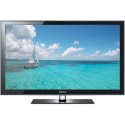Glasses-free 3D HDTV
Glasses-free 3D HDTV in five years?
3D HDTVs have just gone on sale, but they may be as obsolete as a gasoline-powered car in five years.
The powers that be are already working on glasses-less 3D, aka autostereoscopic 3D, with standards expected to be set in around three years with another two years or so for commercialization. So we could have 3D with no glasses by Christmas 2015? We're in!
Here's how it might work:
There are two distinct developing technologies for glassless 3DTV — the 3D video codec and the plasma/LCD display — that have to merge to create a new autostereoscopic 3D ecosystem.
Current 3D is encoded using an extension of MPEG-4 H.264 AVC called MVC (Multiview Video Codec). MVC fuses two nearly simultaneous HD "views," one for the left eye and one for the right. Overlaying these two synced "views" using active shutter glasses creates the perception of 3D depth.
In development is an extension of the MVC extension called MVD (Multiview Video Depth), also called 3DV. MVD adds extra data for additional "depth" layers and multiple views (probably more than a dozen) to create a multi-level stereoscopic image that you won't need glasses to view.
To decode, generate and view these multiple "views," however, requires a lot more signal processing power, resolution and new methods of display than available using current plasma and LCD 3D technology. First, you need ultra HD 4K, capable of displaying around 8 million pixels; current HDs display around 2 million pixels. At CES, Panasonic hung an astounding six-foot-wide 4K plasma, pictured, which also was used inside its 3D demo room.
Once you have the resolution, the screen has to be capable of "projecting" these multiple depth views through a 3D HDTV's glass. One multi-view projecting method is called "lenticular 3D," a really advanced version of those 3D cards that came in CrackerJack boxes that you shift slightly back-and-forth to see a 3D image. Lenticular 3D already is being used for static displays, such as this Transformers poster. Another glasses-less 3D scheme is called Parallax Barrier.
The point is, glasses-less 3D HDTV is not an if — it's a when. We're told all the technologies are understood; it's just a matter of putting the codec and display pieces all together and building the damn thing.
So should you hold off until 2015 on buying 3D HD gear just coming out now? Will you need a new 3D Blu-ray copy of Avatar in five years to replace the copy you'll buy this fall? Stay tuned.
By Stewart Wolpin



0 ความคิดเห็น:
แสดงความคิดเห็น
สมัครสมาชิก ส่งความคิดเห็น [Atom]
<< หน้าแรก